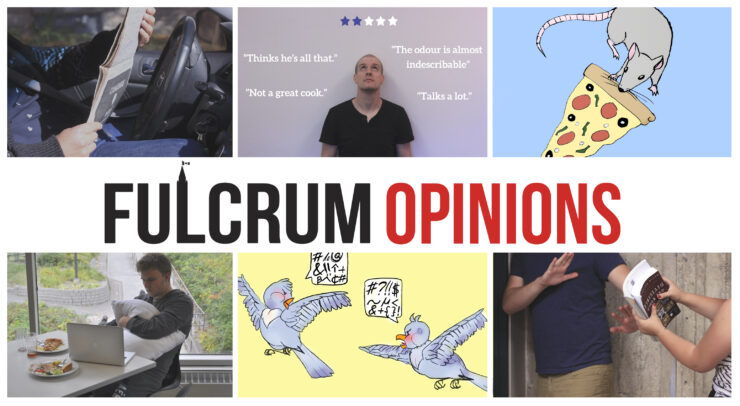EVERY YEAR, THE Student Federation of the University of Ottawa (SFUO) Elections Office releases a report outlining their activities throughout the SFUO election period. The report reviews logistics, results, appeals, and mentions any issues that came up during the elections, with some final comments how the elections ran in general.
While self-reflection is an integral part of personal development, sometimes an impartial observer is necessary to offer its observations and to highlight opportunities for growth. And so, the Fulcrum presents our first-ever election report, reviewing how the Elections Office organized this year’s SFUO elections and offering our recommendations for next year.
Section I: Promotions
I.I: Postering
The Elections Office used posters to promote the elections, which were visible throughout campus; however, the design and slogans that were chosen could have been more prominent.
I.II: Website
The SFUO elections’ website, Sfuoelections.ca, contained candidate profiles, location of polling stations, and information on the referendum question. Information regarding nominations, affiliations, election night, and official release of the election results were not made available on the website in a timely manner. The website was also missing key information (refer to Section II.I).
I.III: Social media
The Elections Office did not actively engage the student population through the use of social media. Twitter and Facebook use was minimal—particularly during the voting period (Feb. 14–16). Events organized by the office, such as the debates and release of the election results on both the evening of Feb. 16 and the afternoon of Feb. 17, were poorly advertised.
I.IV: Engagement of student population
In order to increase voter turnout among students, the Elections Office offered students who voted the chance to be entered into a draw to win an iPad or gift certificates to SFUO businesses. This option was emphasized over informing the student population about the role of the student federation on campus, the platforms of the respective candidates, and the importance of voting in the elections.
Section II: Transparency
II.I: Accessibility to documentation
Although the Elections Office put information like the candidate platforms and polling stations online, critical information such as the results of the candidates’ bilingual testing, violations of electoral rules that occurred over the course of the election period, and past election reports were not on the elections’ website.
The documentation included on the website—such as electoral rules, and affiliations, volunteer, and complaint forms—are located under a tab found on the bottom right-hand side of the website, which is much less prominent compared to the other information featured on the site.
II.II: Appointment of the election officers
The members of the Elections Office are currently appointed by and accountable to the Elections Committee, which is comprised of members of the Board of Administration. Although the office aspires to remain unbiased and uphold the electoral rules of the federation in order to ensure fair, transparent elections, the manner in which the office itself is appointed allows for bias—intended or not.
Section III: Election night and preliminary results
Although the Elections Office initially decided against holding an election night, preliminary results were released on the evening of Feb. 16. The event was not highly publicized, and the majority of students waiting for the results were either part of the student media, candidates, or those who worked on executive campaigns.
Projected to be released at 11 p.m., the results were announced shortly after 2 a.m. that evening. Communication between the Elections Office and those waiting for results was non-existent. The delay resulted in the tech crew packing up at 1 a.m., when they were scheduled to finish for the evening; the results were announced without a projection screen or a microphone. At that time, results were given in the form of the number of ballots cast for the winning candidate—a percentage was not given.
Section IV: Voter turnout
Voter turnout was 15 per cent this year, up from roughly 11 per cent last year. With the introduction of e-voting, voter turnout was approximately 27 per cent and 22 per cent in 2009 and 2010, respectively. When compared to voter turnout in student elections within Canadian universities of a similar size, the University of Ottawa’s turnout ranks relatively low.
Section V: Conclusions and recommendations
V.I: Conclusions
It is in the opinion of this commission that, while the elections were conducted in a fair fashion, the Elections Office needs to re-evaluate its commitment to transparency, objectivity, and engagement with the student population at the University of Ottawa.
V.II: Recommendations
1. The Elections Office needs to engage students through social media, particularly Facebook and Twitter, as the majority of the student population is active on these mediums.
2. The Elections Office should refrain from offering students rewards for participating in the electoral process, and instead should focus their attention on increasing awareness and access to information regarding the elections in order to promote student participation.
3. The Elections Office should post all relevant documentation to the elections, including the results of bilingual testing, any violations of electoral rules by the candidates throughout the elections process and the actions taken to remedy misconduct, and all subsequent election reports, on their website to increase the transparency and accountability of the organization.
4. The members of the Elections Office—ie. the chief electoral officer and the chief returning officer—should be appointed by an independent, impartial body in order to ensure the unbiased nature and legitimacy of the organization.
5. The Elections Office needs to give students, particularly the student media, a realistic time for the release of preliminary results.
6. Because delays have been experienced with respect to the release of election results in the past two years, the Elections Office should reassess the efficiency by which they collect and count ballots.
7. The Elections Office should reassess their use of e-voting in SFUO elections in order to increase voter turnout.
editor@thefulcrum.ca | 613-562-5261



